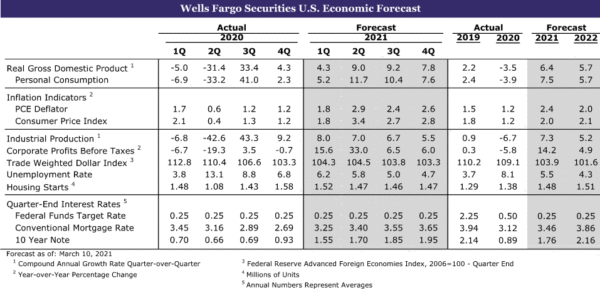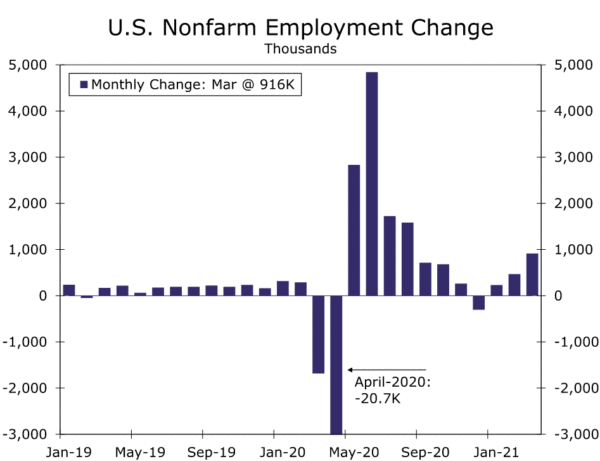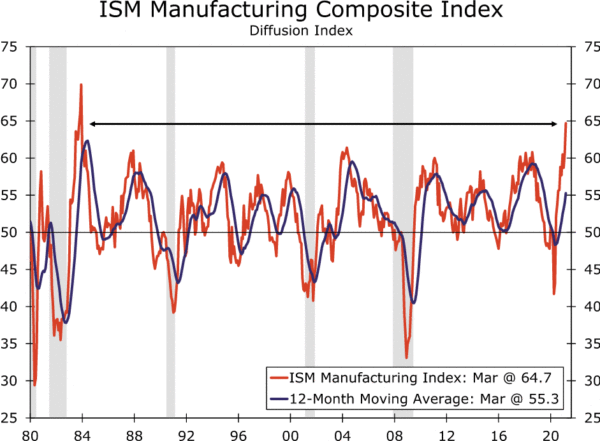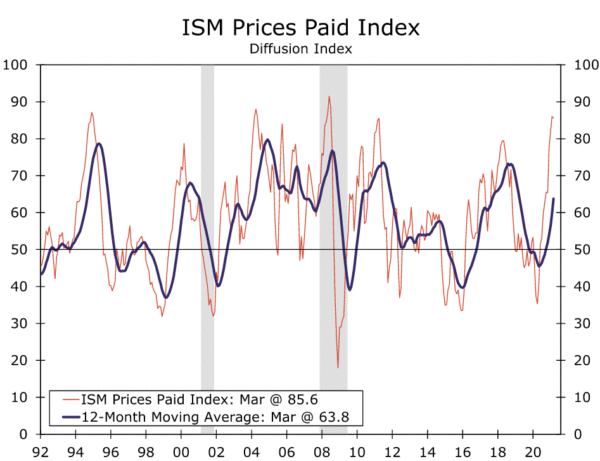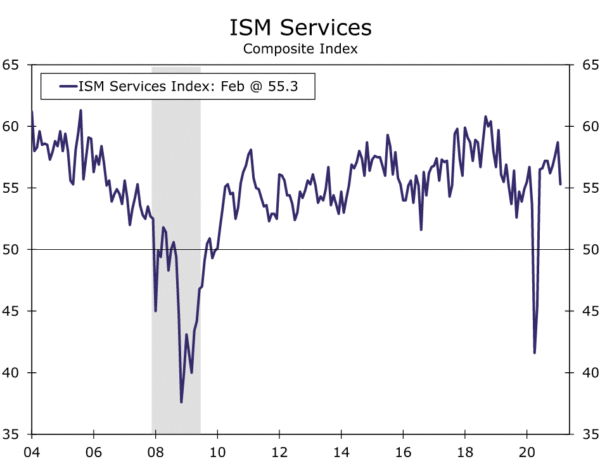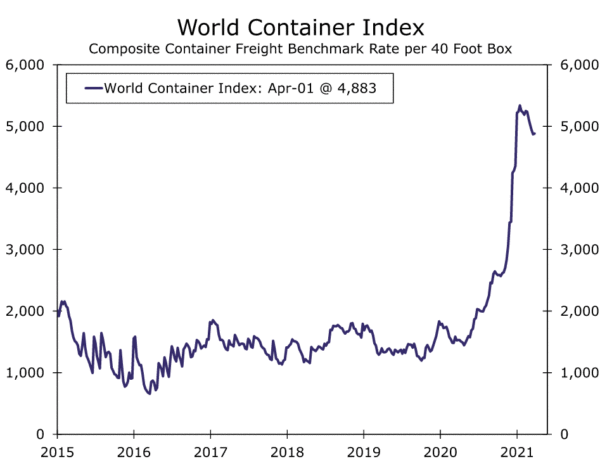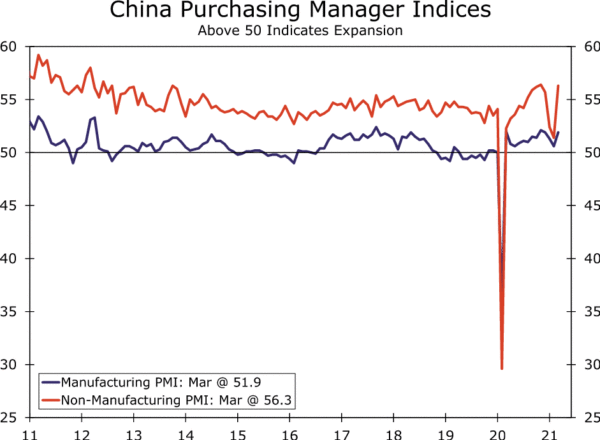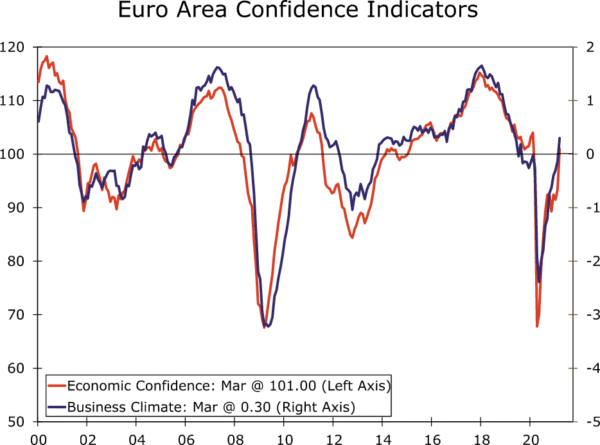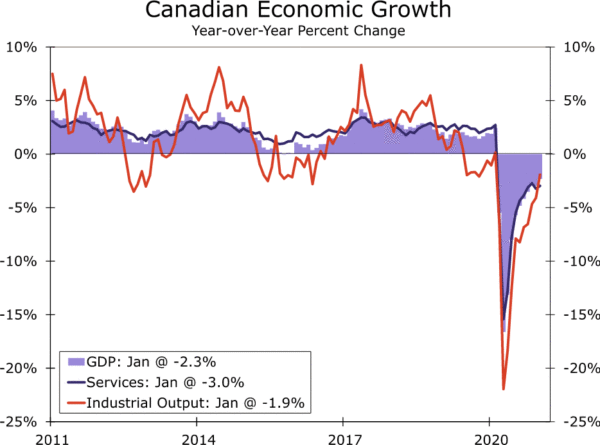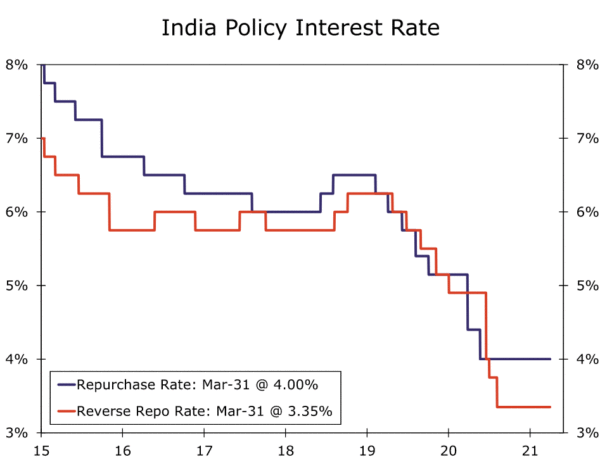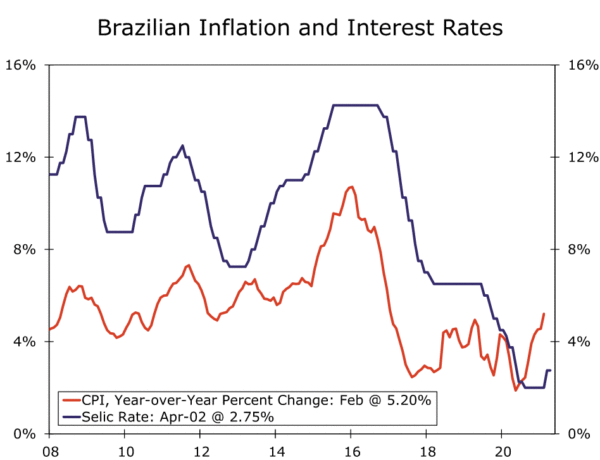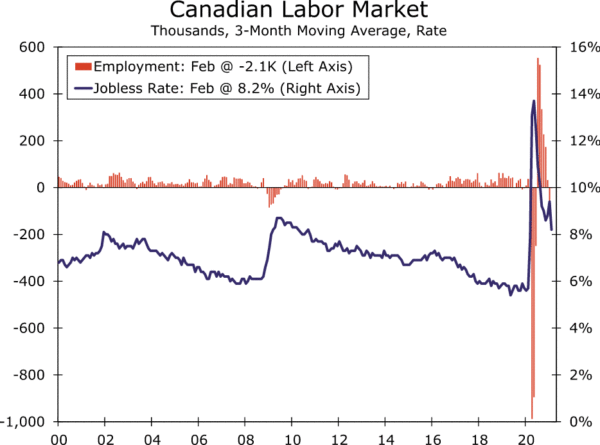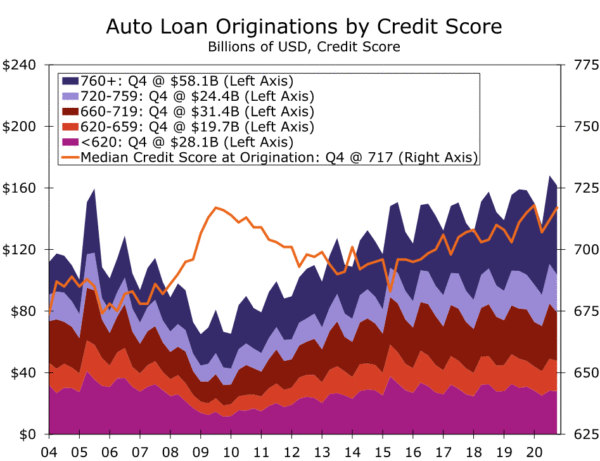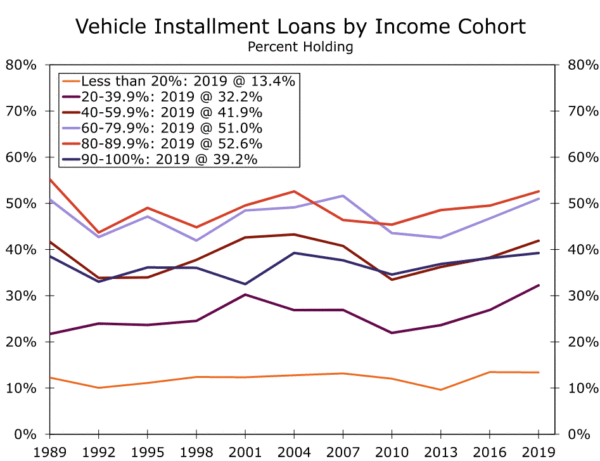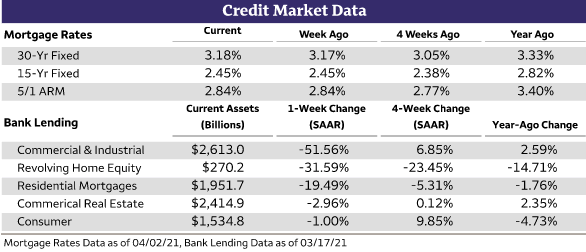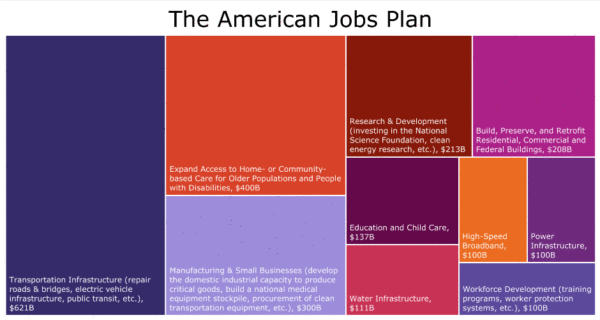Summary
U.S. Review: Activity Marches Higher
- The improving public health position led to an easing of restrictions and pickup in activity across the country in March. Data this week show an economy set to fire on all cylinders. The daily vaccination pace continues to improve, employers added an impressive 916K net new jobs last month, the ISM manufacturing index has soared to its highest level in nearly 40 years and the S&P 500 index reached a record high. But we have a supply problem.
International Review: China and Canada Outperform, but Eurozone Survey Data Misleading?
- China PMI’s moved higher in March as COVID cases and restrictions receded, a signal that China’s economy is still leading the global economic recovery. Monthly GDP data in Canada also revealed the Canadian economy is outperforming relative to expectations. We remain optimistic on the country’s growth prospects.
- Eurozone economic and business confidence surveys jumped higher in March; however, these data could wind up being misleading as the Eurozone’s struggles with COVID and vaccine distribution remain prevalent. In the coming months, it would not be surprising to see activity data and confidence surveys turn lower.
Credit Market Insights: Auto Loans No Longer Top-of-Mind: Are New Challenges Down the Road?
- The tables have turned for how consumers prioritize paying back outstanding loans. New data from the Federal Reserve Bank of New York highlights that mortgage payment prioritization has rebounded and even surpassed auto loans in recent years.
Topic of The Week: Infrastructure Week: Part Two Trillion
- On Wednesday, the Biden administration put forth “The American Jobs Plan” (AJP), a sweeping proposal that calls for roughly $2.25 trillion in public investments over the remainder of this decade. The AJP also includes proposed tax hikes to pay for this new spending.
U.S. Review
Activity Marches Higher
Increased vaccinations and an improving public health position led to an easing of restrictions and pickup in activity across the country in March. Firms’ need for labor has increased to meet demand and employers added a whopping 916K jobs last month as the recovery gained momentum (see Chart). Prior job gains were revised higher as well, but the March figure still denotes a significant pickup from the first two months of the year.
For the second consecutive month, the hard-hit leisure & hospitality industry posted a solid gain (+280K), as in-person activity continues to recover. Construction payrolls also jumped 110K last month after severe winter weather weighed on the industry in February. Overall, hiring was broad based with nearly every major industry reporting gains. The few exceptions were the autos & parts and information industries, which reported very modest declines in net hiring of -1K and -2K, respectively. The unemployment rate slid 0.2 percentage points to 6.0% in March.
Despite the solid jobs report, there is growing evidence that businesses are having trouble finding labor. A record share of businesses reported at least one position as hard to fill in March, and some manufacturing industries in the March ISM report noted labor challenges and a lack of qualified talent were affecting hiring and production.
In short, we have a supply problem. We’ve explored supply constraints in a recent special report, and it’s not just labor that is giving businesses trouble. The surge in durable goods spending by consumers and core capital goods spending by businesses has occurred alongside a worsening shortage of key materials and goods. The inventory-to-sales ratio has collapsed to nearly a 15-year low as a result. More simply, businesses can’t get their hands on the stuff they need.
Delivery times have surged and the supplier deliveries component of the March ISM manufacturing survey this week jumped to 76.6, which is its highest level since 1974 when the oil embargo’s effects were still fading. The ISM accepts submissions right up to the end of the month, so the Suez Canal blockage seems to have factored into supply chain dynamics, if only mentally at this point. But the recent blockage only builds on strains, like severe winter weather across the country in February and continued congestion at U.S. ports, that were well under way prior to last week’s prolonged closure of one of the world’s most important waterways.
Still, manufacturing sentiment is the most upbeat it has been in recent memory. The overall ISM manufacturing index catapulted to 64.7 in March, which is the highest reading in 37 years (see Chart). Despite growing backlogs and hassle from supply problems, orders continue to roll in and firms are experiencing some pricing power.
Trans-Pacific shipping rates have tripled since 2019. Most industrial metals prices are up double digits in percentage terms just since the start of this year. The ISM prices paid index remains near the highest level since 2008 (see Chart), but unlike that year, consumer and business demand is surging. All 18 industries of the ISM manufacturing survey reported increases in raw materials last month. With new orders and backlogs surging to new cycle highs, we expect manufactures to take advantage of the pricing power that was largely absent in the previous cycle and pass some costs on.
We still expect the upward pressure on prices to be sharp but temporary. If that is the case, the Fed can brand these price pressures as transitory and not rush to take the punch bowl away, particularly with progress still left to be made on the employment side of its mandate. Once global supply chains normalize and businesses can get their hands on the input components they need, we are forecasting a faster rebound for manufacturing than what occurred in the wake of the past two recessions.
The improving economic backdrop illustrated in the strong data this week helped propel the S&P 500 index to close above 4,000 for the first time on Thursday. President Biden’s $2.25 trillion infrastructure bill, which has the potential to provide another boost to growth, was also likely a factor in market participants’ optimism. For more detail on the bill, please see our Topic of the Week section.
U.S. Outlook
ISM Services • Monday
The ISM Services index was not immune to the slowdown seen across the economy in February. The index slipped 3.4 points to its slowest pace of expansion since May 2020. The new orders index fell even further, down 9.9 points to 51.9, though some of this decline may reflect the fact that long-depleted inventories have at last been restocked.
While all the major sub-indices remained in expansionary territory, February’s deceleration was disappointing for an index that had showed strength through much of the winter slowdown. We continue to believe that the service sector is set up for a strong year ahead, as increasing vaccinations and fiscal support allow consumers to start spending on services that have been restricted since the start of the pandemic. In addition to signs of the service sector rebound, we will be looking for indications of ongoing supply chain problems in this month’s report. The supplier deliveries sub-component has remained elevated since it hit an all-time high of 78.3 at the start of the pandemic. Increases in this component contribute positively to the headline index, given it traditionally indicates strong demand. In the COVID crisis, however, it has reflected purchasing managers’ difficulty sourcing inputs, which could be a headwind for the sector if problems persist as demand comes back online. Altogether, we believe these factors will push the index to 60.5 in March.
- Previous: 55.3
- Wells Fargo: 60.5
- Consensus: 58.9
Trade Balance • Wednesday
Global trade has been slowly coming back online after falling off a cliff last spring. Given the United States has bounced back faster than many other parts of the world, this rebound has led to a widening of the trade deficit, as imports outpace exports. In February, we expect the trade balance to widen further to -$70.5 billion, but for trade flows to slow overall. Advance trade data suggest goods exports fell 3.8% month-over-month and goods imports slid 1.4% month-over-month. Global trade had been strained even before the Ever Given made headlines for blocking the Suez Canal. When the world economy shutdown last year, many orders with suppliers and transporters were canceled as people struggled to figure out how long we would be in lockdown, and what the demand picture would be on the other side. When goods demand rebounded faster than many anticipated, shipping costs soared and producers scrambled for inputs.
While trade has been able to grow despite these headwinds, we expect they will factor into the February report and in the coming months, particularly on the imports side. Cargo ships have been forced to anchor outside the Los Angeles and Long Beach ports, where about a third of goods imports come through, as the ports struggle to unload the incoming ships. While strained supply chains may also be a factor on the export side, slower growth abroad will likely constrain demand. Moving forward, we believe imports will continue to rebound faster than exports, which will lead to large drag on GDP in H1-2021, until exports pick up more meaningfully in H2-2021 and into next year.
- Previous: -$68.2 Billion
- Wells Fargo: -$70.5 Billion
- Consensus: -$70.5 Billion
International Review
China PMI’s Tick Higher
The Chinese economy has been a notable outperformer over the past year, and we expect this trend to continue going forward. However, earlier this year a small COVID outbreak close to Beijing resulted in new restrictions and lockdown measures. These restrictions placed modest downward pressure on the local economy as witnessed by multiple consecutive months of declines in the manufacturing and non-manufacturing PMIs. With COVID cases receding, restrictions have been lifted allowing for mobility around Beijing to improve. This week, the positive impact of fewer restrictions became apparent as the PMI indices ticked higher in March. To that point, the manufacturing PMI moved higher to 51.9, while the non-manufacturing PMI firmed to 56.3. The move higher in the PMI indices is a welcome development and reaffirms our view for the Chinese economy to perform quite well over the course of 2021. As of our latest forecasts, we believe the Chinese economy will grow more than 9% this year, an above-consensus growth forecast, and well above China’s long-term trend.
Eurozone Confidence Climbs, but for How Long?
This week, survey data revealed confidence in the Eurozone picked up in March. Both the economic confidence and business climate surveys rose sharply in March, which in our view, is somewhat surprising given the struggles the Eurozone is having with COVID and vaccine distribution. As far as COVID, most of the major countries across the Eurozone have reimposed restrictions, most recently France and Germany. With restrictions going back into place, the short-term economic outlook for the Eurozone is deteriorating even further, compounded by vaccine distribution lagging considerably relative to the United States and the United Kingdom. Over the next few months, we expect economic and sentiment data to begin to drift lower. Activity, mobility and survey data should start to deteriorate as restrictions get put in place, and fiscal stimulus still seems a few months away. With the economy likely to decelerate even further in the coming months, it would not be all that surprising if the European Central Bank (ECB) looked to ease monetary policy even further. While rate cuts seem unlikely, additional asset purchases seem possible. On the basis of possible monetary easing and COVID issues, we recently revised our outlook for the euro lower, while risks around our currency and economic forecasts remain to the downside for the time being.
Canadian Economy Gathering Momentum
We continue to believe the outlook for Canada’s economy is reasonably robust as activity indicators begin to improve. February’s employment data signaled the labor market is recovering ahead of schedule, while strong retail sales are encouraging for the health of the economy. In addition, elevated and stable commodity prices should support the economy as well as the currency at least for the time being. That combination led to a strong monthly January GDP print this week. On a month-over-month basis, the Canadian economy expanded 0.7%, beating consensus forecasts. On a year-over-year timeframe, the economy recorded a contraction of 2.3%, also better than consensus forecasts had estimated. As a result of an improving economy, the Bank of Canada (BoC) has started to prepare financial markets for the possibility of less monetary policy accommodation in the near future. Recent actions combined with policymaker comments lead us to believe the BoC will announce further tapering of its asset purchases as soon as the April meeting. In addition, we believe the BoC is on pace for a rate hike earlier than the central bank is currently signaling and see a 25-bp hike in the second half of 2022. While our view on a 2022 rate hike is out of consensus at this point, we are comfortable baking tighter monetary policy into our forecasts.
International Outlook
Reserve Bank of India • Wednesday
Next week the Reserve Bank of India (RBI) will meet to assess monetary policy. India’s economy has recovered quite well over the past few months; however, COVID cases are beginning to rise in and around the city of Mumbai. Modest restrictions have been put back in place in an effort to contain the spread of COVID, which is why we believe the RBI will maintain its accommodative monetary policy stance. Despite an accommodative policy stance, we expect India’s central bank will keep policy rates on hold next week and for the foreseeable future. CPI inflation in India has been volatile over the past few months as energy and food prices push higher. With commodity prices elevated and stabilizing, inflation is likely to rise over the next few months. As a result, we believe the RBI will opt to keep interest rates steady and not risk runaway inflation above the RBI’s upper range of its inflation target.
- Previous: 4.00%
- Wells Fargo: 4.00%
- Consensus: 4.00%
Brazil Inflation • Friday
Inflation in Brazil has been on an upward trajectory for months as the effects of fiscal stimulus, higher commodity prices and a significantly weaker currency take effect. According to consensus forecasts, inflation is expected to move higher to 6.2% year-over-year, well above the Brazilian Central Bank’s CPI target. The rise in inflation presents an issue for the Brazilian Central Bank (BCB), especially at a time when an additional round of fiscal stimulus has been approved. In an effort to contain price growth, the central bank recently started hiking policy rates, raising its Selic Rate 75 bps at its latest meeting in March. In addition, the BCB signaled an additional 75 bps of tightening is likely at its next meeting in an effort to contain inflation and defend the value of the currency. Inflation above 6% could result in more aggressive monetary tightening, which could weigh on the local economic recovery. Brazil’s economy is already struggling to gather momentum, and with daily COVID cases at historical highs, aggressive rate hikes could create additional headwinds for the economy.
- Previous: 5.2%
- Consensus: 6.2% (Year-over-Year)
Canada Unemployment Rate • Friday
As mentioned earlier, the Canadian economy has been strengthening over the past few months. Perhaps, most notable has been the improvement in local labor market dynamics, especially as it relates to February data. Last month, the Canadian economy created 259,200 jobs, well above consensus forecasts calling for just 75,000. In addition, the jobless rate fell to 8.2% from 9.4%, while the labor market participation rate held steady at close to 65%. Improvements in the labor market also contribute to our optimistic outlook on the Canadian economy, and if March employment data follow suit, the outlook could brighten even further. Next week, consensus estimates suggest another 90,000 jobs could be created in Canada and for the jobless rate to tick lower to 8.0%. As far as recovering lost jobs, the Canadian labor market is outpacing the United States and most other developed economies. With oil prices pushing higher and the domestic economy stabilizing, it is also possible more energy sector jobs are created in the months ahead. When sifting through March employment data, we will be cognizant of any revisions to February data purely given the size of the outperformance last month.
- Previous: 8.2%
- Consensus: 8.0%
Credit Market Insights
Auto Loans No Longer Top-of-Mind: Are New Challenges Down the Road?
The tables have turned for how consumers prioritize paying back outstanding loans. Studies have shown that consumers typically prioritize auto loan payments compared to credit card or mortgage payments. This is in part due to mortgage payment prioritization slipping following the Great Recession. But new data from the Federal Reserve Bank of New York highlight that mortgage payment prioritization has rebounded and even surpassed auto loans in recent years.
While lower prioritization may seem to reflect changing preferences, it has potential to have important implications for debt serviceability and consumer spending more broadly. This is especially true as the forbearance periods end for mortgages and student loans, whose delinquency rates have decreased significantly over the past year as a result. Auto loans, however, have seen overall serious delinquency rates (90+ days) stay relatively consistent around 5% over the past two years. Consumers will soon again be tasked with juggling multiple payments at once as forbearance ends, and auto loan payments may be in a riskier position of being dropped.
That said, there are other reasons besides their typically high-ranking priority among consumers that have not led us to lose sleep over how auto loans are affecting the household debt profile. Auto loans have risen at an extraordinary rate over the past cycle. In the past 10 years, the amount of auto debt has nearly doubled and currently stands at $1.4 trillion. However, total auto loans today amount to less than a fifth of what residential mortgage debt totaled just over a decade ago, which at the time exceeded $9 trillion. Therefore, the smaller magnitude of auto loan debt does not give it the same power over the economy.
Furthermore, the median credit score of auto loan holders has been trending higher in recent years and, in Q4-2020, matched the high reached at the end of the Great Recession (see Chart). The downturn has disproportionately hit lower-income households, which suggests borrowers with lower credit scores have a higher chance of default once forbearance periods end, stimulus fades and unemployment benefits run dry. Still, a breakdown of auto loans by income shows that many of the harder-hit, lower-income households are not the primary holders of auto debt. Only 13.4% of persons in the lowest income category hold auto loans (see Chart). For these reasons, we are not presently concerned about a significant rise in auto delinquencies weighing on consumer spending despite the lower prioritization placed on auto loans by consumers.
Topic of the Week
Infrastructure Week: Part Two Trillion
On Wednesday, the Biden administration put forth “The American Jobs Plan” (AJP), a sweeping proposal that calls for roughly $2.25 trillion in public investments over the remainder of this decade. A breakdown of this new spending can be found below. In short, the package includes funding for a broad array of policy proposals, ranging from physical infrastructure projects to clean energy projects to high-speed broadband and workforce development programs. The AJP also includes proposed tax hikes to pay for the new spending. The plan’s tax hikes are concentrated on the corporate side of the tax code, and call for raising the corporate income tax rate to 28% from 21%, introducing a 15% minimum tax on corporations’ “book income,” increasing the minimum rate on global intangible low-taxed income (GILTI) to 21% from 10.5%, assessing it on a country-by-country basis and eliminating the qualified business asset investment (QBAI) exemption. Our initial thoughts on this proposal are that something along these lines probably can pass Congress and become law by the fall, although we expect the $2.25 trillion in proposed spending and the corresponding tax increases will be shaved down somewhat over time.
In our view, the biggest thorn is that there were a lot of potential changes left out of Wednesday’srelease. Reports have been circulating for weeks that the Biden administration will lay out a second plan sometime in April that will include a host of other proposed social welfare changes, such as federal paid family leave, free community college, universal pre-K and extending the recently expanded Child Tax Credit. While the details remain unclear, these proposals could add another $1 trillion to $2 trillion on top of the roughly $2 trillion proposed Wednesday. We believe the Biden administration will need to dig deeper into its bag to ensure there is enough long-term revenue to make these additional programs permanent. We would take the under on $3 trillion to $4 trillion in total, but if spread over a decade or longer, an eventual package (combined or in multiple parts) of $2 trillion to $3 trillion could very well be in the cards. If we are correct, corporate and personal income taxes would likely be headed higher in the not-too-distant future.
From an economic perspective, our views have not changed much from our previous report. The recently enacted $1.8 trillion American Rescue Plan supercharged growth and inflation expectations, because it was deficit-financed and spent almost entirely over a one- to two-year period. In contrast, if a $3 trillion infrastructure/social welfare package is spent evenly over eight years, that comes to $375 billion per year. The economic impact from that new spending would at least partially net off against at least $150 billion per year in new taxes. We also suspect that so much infrastructure money would be spent over a longer time horizon.
For further reading, please see our full report on “What Federal Tax Changes Are on the Table?”




